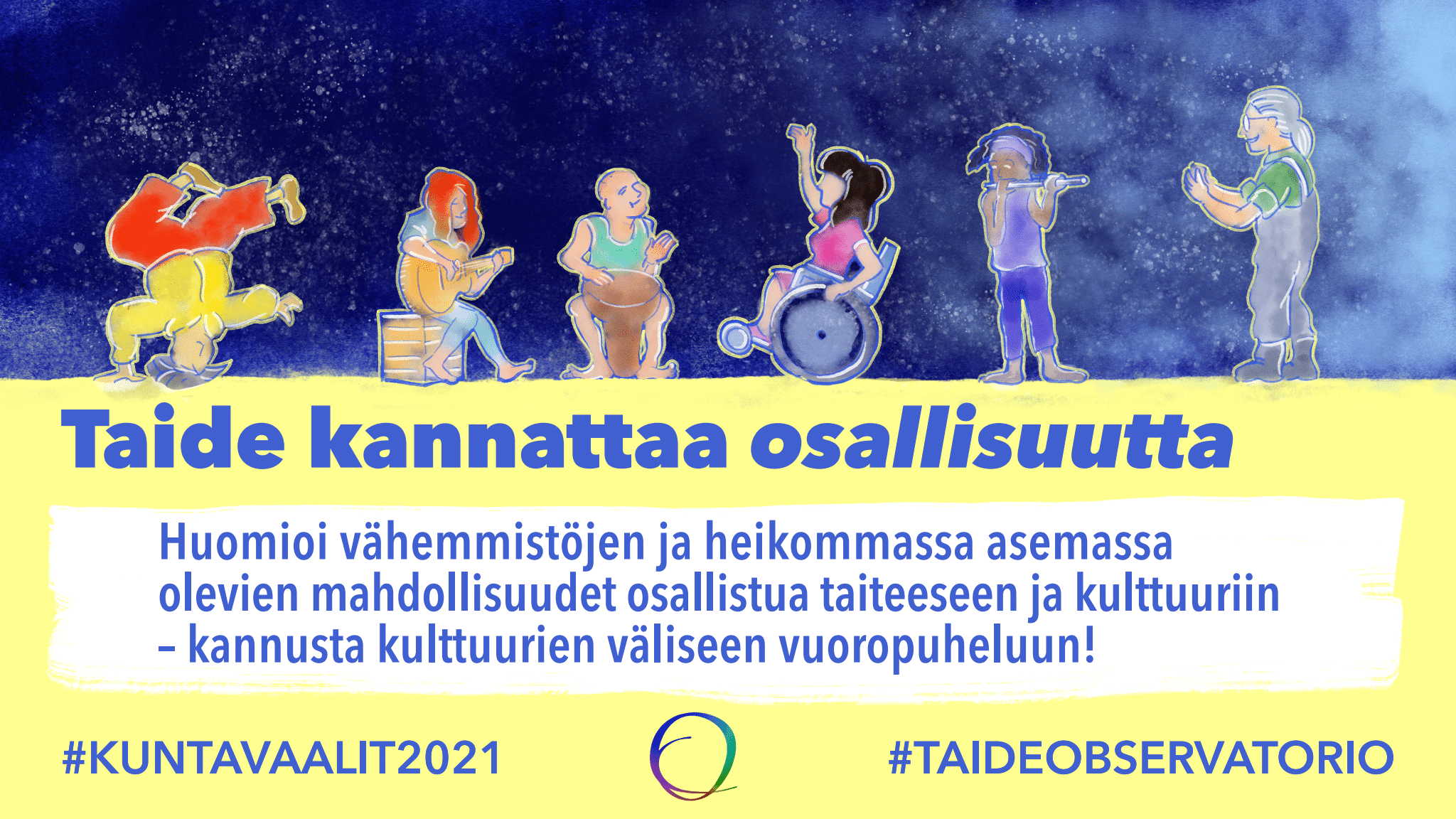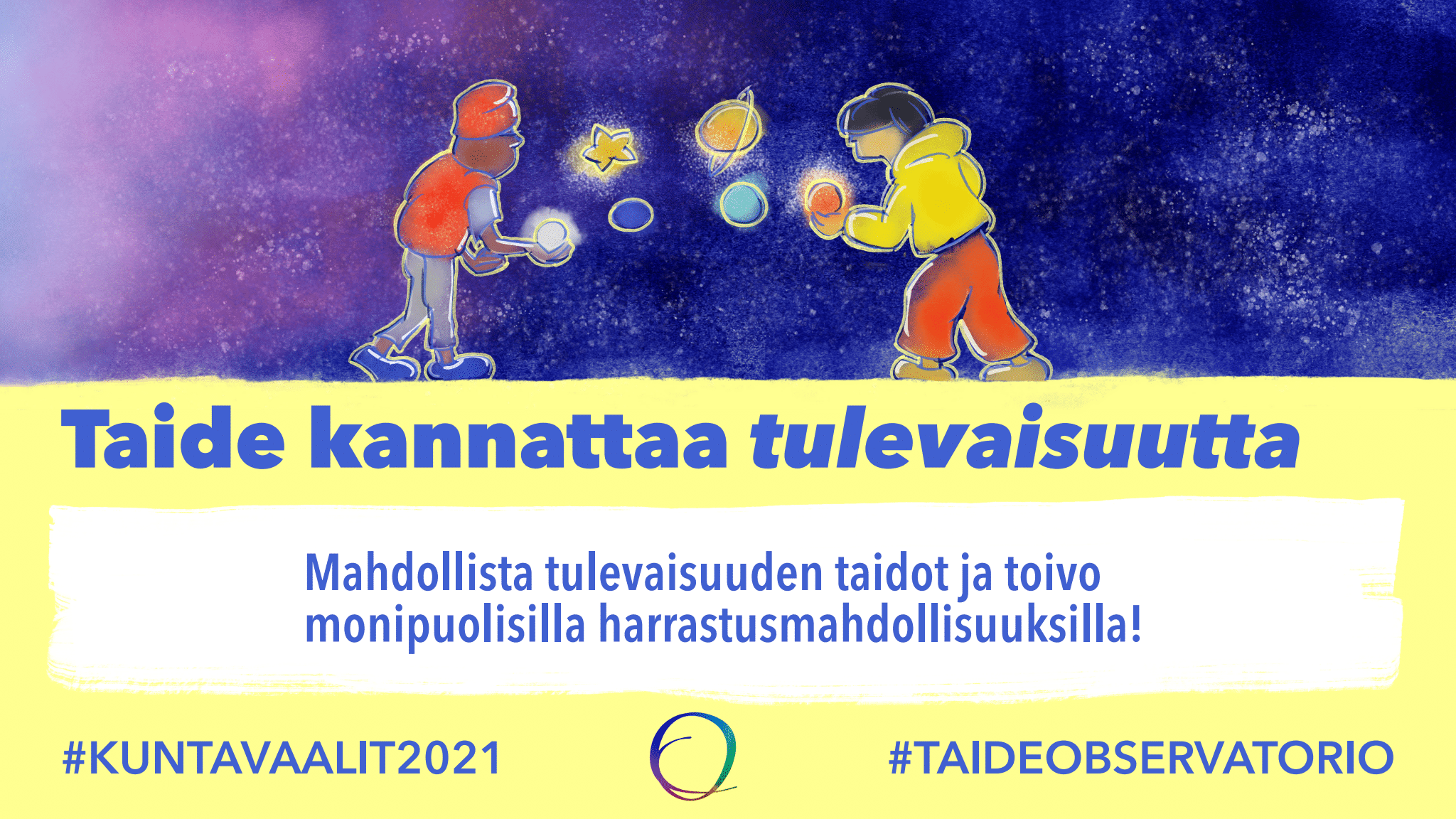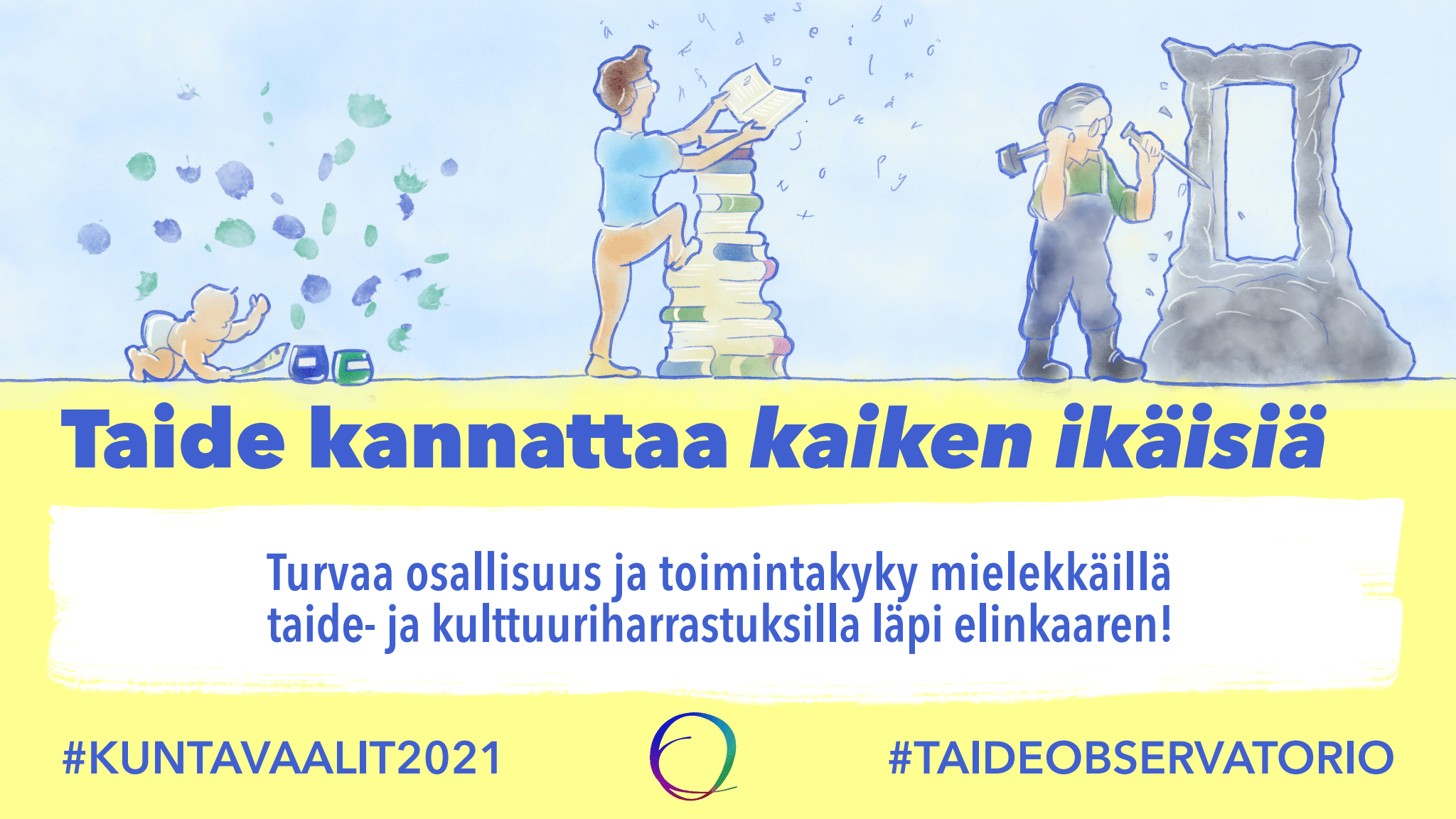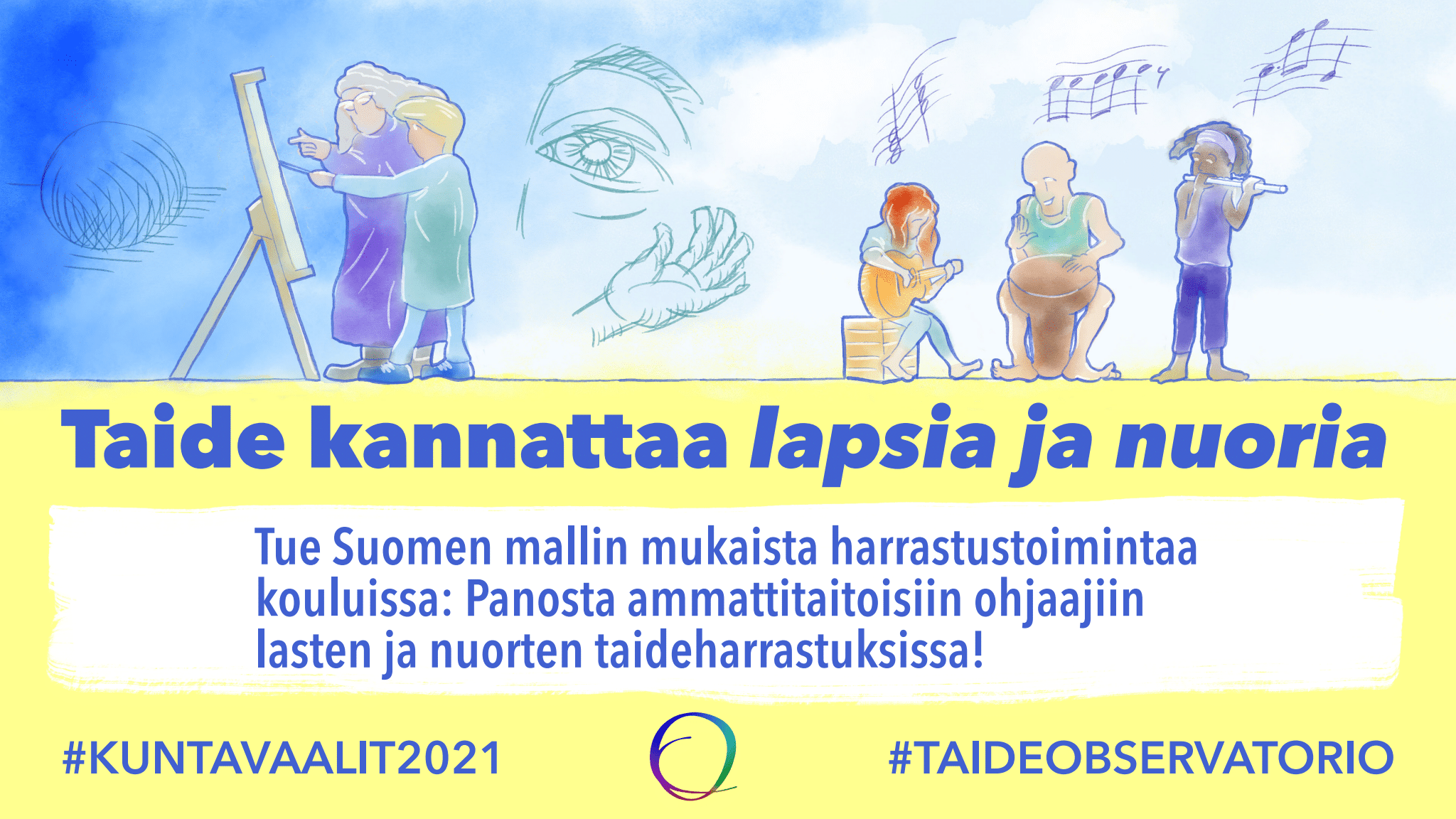Municipal election campaign 2021 - Taideobservatorio
Municipal Election Campaign 2021
Art is worth it!
Art and investing in it support municipalities and their residents. Through its campaign, the Observatory for Arts and Cultural Education Finland wants to bring the themes of art and culture into the municipal election discussions of both candidates and voters. The background documents compiled by the Observatory provide a research-based foundation for the images and theses of the election campaign. The materials of the municipal election campaign are freely available for non-commercial purposes.
Art supports inclusion

Art activities provide a place to meet people from different cultural backgrounds. Arts and cultural projects offer a special field for experiences and experimentation that enables diverse interaction with different groups and learning from one another. For example, offering people from different backgrounds opportunities to participate in art projects is a concrete way to promote intercultural dialogue. Through dialogue, prejudices and assumptions can be questioned and removed, and people can be brought closer together.
Participation in artistic activities can develop social relationships, reduce loneliness and increase the sense of belonging. According to research, art and artistic activities increase agency and the recognition of one’s own skills. These factors are important, for example, in preventing social exclusion. By allocating resources into equal access to art and cultural experiences, we invest in the realisation of cultural rights and humanity. It shows that we respect each other.
Cultural needs are a basic human need in all of us. The United Nations’ Universal Declaration of Human Rights, various human rights instruments that are binding on Finland and the Finnish Constitution guarantee everyone the right to participate in arts and culture, to develop themselves and their community through them, and to express themselves freely. This applies equally to people in all municipalities, all age groups and all backgrounds. In order to safeguard these rights, municipalities must implement an active cultural policy through measures such as cultural education plans and cultural well-being plans.
Sources:
ArtsEqual. (2017). Ratkaisukortit. Taideyliopisto.
Suomen Kulttuuriperintökasvatuksen seura ry & Suomen lastenkulttuurikeskusten liitto. (Päiväämätön). Kulttuurikasvatussuunnitelma. Verkkosivu. (Accessed on 29.4.2021.)
Terveyden ja hyvinvoinnin laitos. (18.12.2020). Kulttuuri hyvinvointikertomuksessa. Verkkosivu. (Accessed on 29.4.2021.)
Art supports the future

In a civilised society, art is of value in itself and as part of the nation’s shared cultural heritage. Throughout history, art has encouraged people to gain experiences. Diverse art experiences involving surprises, pleasure, joy, rage and a wide variety of other emotions challenge us to see differently, stimulate creative reflection, encourage dialogue and give us strength to carry on in life.
Art activities provide the participants with joy and experiences of success and learning while developing their skills. For example, leisure activities in music, theatre or visual arts can continue past childhood and youth and turn into a resource in adulthood, perhaps even a profession. Art activities diversely develop the capabilities needed in life.
We need determination and coping skills to recover from the COVID-19 crisis. Resilience, or people’s ability to recover from hardship, adapt to changes and continue their lives thereafter, is intrinsically linked to coping. Resilience can be strengthened by participating in arts, as experimenting with different approaches and possible solutions in artistic activities can guide the individual towards more flexible thinking and creative solutions. Creating a relationship to art is an essential part of increasing resilience through art. Its creation requires high-quality artistic and cultural activities that are of a high pedagogical standard.
Environmental issues and exerting influence on them are important for a sustainable future. Services tend to have a smaller carbon footprint than goods. Research suggests that the opportunity to focus on an activity that is mentally or physically challenging brings more happiness to people than the consumption of material. Therefore the key to a more sustainable future can be found in art and culture. Through art, environmental communication can be made concrete and people can be activated to participate in environmentally friendly activities. Climate change and the transition to a green economy will further increase the importance of creative industries as drivers of the economy, and the role of arts as a driver of social change in municipalities.
Sources:
Kulttuuri- ja taidealojen keskusjärjestö KULTA ry. (2018). Kulttuurin ja taiteen vaikutukset ihmiseen ja yhteiskuntaan.
Lehikoinen, K. (1.6.2020) Taidetoimintaan osallistuminen voi vahvistaa kykyä toipua vastoinkäymisistä ja jatkaa elämää. [a blog post]
Art supports municipalities

Municipalities are important facilitators of cultural life and providers of cultural services that support art and culture with a larger amount of money annually than the state. Regardless of the size of the municipality, local cultural life is important for the social well-being of the residents. Dynamic cultural life also strengthens the municipality’s ability to attract and retain residents, as a diverse art and cultural programme and opportunities for participation attract young adults and families, those with a higher education, and companies. The opportunity to participate in culture and arts as an observer or as an active agent provides the best welfare effects and, among other things, strengthens social cohesion.
Culture adds more meaningful content to local life, and brings more employment and income. The share of culture in municipal expenditure is often small, but culture can have a positive ripple effect on the municipality’s overall economy through, for example, cultural tourists and direct and indirect effects on employment. Diverse cultural events that are visible in the public space and the good atmosphere, spirit and surprises created by cultural activities attract a variety of people to the municipality and keep them coming back.
ArtsEqual researchers suggest that the basic education institution could be Finland’s largest cultural centre, where high-quality and diverse arts and cultural education is available equally to all pupils. For example, research suggests that the linking of recreational activities in arts and culture to the school day, as enabled by the Finnish model, may enhance school attractiveness by offering students opportunities to take part in activities, express themselves and affect their own environment. This may also improve the sense of community and school satisfaction. Researchers also propose a model for cultural outreach work to strengthen the cultural inclusion of children and young people and to prevent exclusion.
Art supports people of all ages

Art and culture bring more strength and resources to people in other areas of life, too. The right to participate in art and culture, self-expression and self-development are everyone’s fundamental rights. They are safeguarded by the United Nations’ Universal Declaration of Human Rights, the Finnish Constitution and many international treaties that oblige Finland. Allocating resources into art and culture is an investment in people both in terms of the meaningfulness of life and local government finances. Cultural and artistic activities promote well-being and thus enable cost savings in social welfare and health care, among other things.
From the perspective of holistic well-being, wellness is understood as a combination of the standard of living, quality of life and happiness, and it includes friendships, self-realisation and perceiving oneself as meaningful, as well as significant leisure activities. The achievability of well-being is primarily based on the elimination of inequality and the pursuit of equality in art services and in society at large. Fairness is intrinsically linked to everyone’s real possibilities to act and the freedom of choice. In addition, the achievement of well-being must also be understood from the perspective of people’s functional capacity. In this context, functional capacity means the real opportunities for people to be themselves and act in the manner of their choosing to achieve personal well-being. Well-being is based on everyone’s freedom to choose how to act or not to act in their personal life. However, people do not have equal abilities or strength to make informed choices about their well-being in terms of participation in arts and culture. Could a cultural recipe and low-threshold services and customer guidance in municipalities be a way to dismantle inequalities in terms of finding meaningful art and cultural services for everyone?
Art and culture can also provide tools for the health care sector. According to a report by the World Health Organisation, arts can affect, for example, social factors in health, promote children’s development, contribute to health-promoting behaviour, prevent illnesses and support nursing. It is also possible to support people living with neurological disorders or recovering from mental health issues through art. The UN has warned against the global mental health crisis as one of the consequences of the COVID-19 pandemic. Consequently, it is important for the welfare society to see the potential of arts as a concrete support measure provided by society.
Participation in art and cultural activities is a path to lifelong learning. However, inclusive art and cultural activities should not only be regarded as a medicine to combat ageing or loneliness. Neither does the provision of artistic activities for the elderly mean that people are activated to ensure a reduced care burden. Leisure activities in the arts can provide opportunities to achieve meaningful experiences that guide people to focus their resources on what they want. The health-enhancing effects of art are certainly achieved alongside the activities, but they are secondary to the most important impacts and benefits of artistic and cultural activities: significant experiences, feelings of meaningfulness, as well as growth as a human being, and enabling of new identities.
Sources:
Art supports children and young people

The main objective of the Finnish model for leisure activities is to increase the well-being of children and young people by enabling every child and young person to have a leisure activity that they can enjoy free of charge in connection with the school day. The activities on offer are based on children’s and young people’s own wishes, which have been charted in a school pupil survey, amongst others. The activities are organised through the coordination of existing good procedures and practices, and cooperation between schools and actors in leisure activities. The first leisure activities enabled by the model were implemented in spring 2021, when the model was piloted in 117 municipalities. In the spring, it was possible for municipalities to apply for recreational grants for the autumn of 2021. The aim is to make the Finnish model into a permanent approach in municipalities through an annual call for government grants. The model helps to improve the equal opportunities for children and young people to engage in leisure activities in a meaningful and child-oriented manner while investing in the pedagogical quality of their activities.
In people of all ages, strengthening of the personal relationship to art and culture and the accumulation of cultural capital are linked to social inclusion, well-being and the meaningfulness of life. Cultural capital that develops through, for example, cultural interaction with the surroundings affects children’s learning outcomes, academic ability and educational choices. Consequently, the effects of familiarising children and young people with art activities can be noticeable from the perspective of both individuals and society also in the long term. In order to make the good effects of art education reach an even larger number of people, the accessibility of art activities must be improved. The structures and implementation methods shall not exclude anyone from the activities. If a leisure activity starts in a high quality and inspirational manner, the participants may enjoy it for decades with friends they have gained through the activity, learning new things and appreciating it.
Sources:
Opetus- ja kulttuuriministeriö. Suomen malli. (Accessed on 29.4.2021)
Opetus- ja kulttuuriministeriö. (4.2.2021) Saarikko: Harrastamisen Suomen mallin seuraava vaihe liikkeelle. (Accessed on 29.4.2021)
Suomen taide- ja kulttuurikasvatuksen observatorio. (12.6.2020) Lasten ja nuorten harrastusmahdollisuuksia edistävä Suomen malli toteutuu! (Accessed on 29.4.2021)
